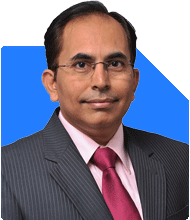Ramalingam Kalirajan |7545 Answers |Ask -Follow
Mutual Funds, Financial Planning Expert - Answered on Jan 16, 2025
He has an MBA in finance from the University of Madras and is a certified financial planner.
He is the director and chief financial planner at Holistic Investment, a Chennai-based firm that offers financial planning and wealth management advice.... more

I m 40yrs , single woman. I have no any source of income. No own home, no any other help or support. I have only 40-45 lac for survival, now I want to know how I invest this amount so that I can get atleast 40k per month for monthly expenses? And amount should not be so risky, like in fds I can't get that much interest as much I need and in mutual fund or stocks there is risk. And except this fund , i don't have anything more. So I want to invest this amount very safely for my monthly expenses and for emergency funds too at any point of time. Please suggest?
1. Assess Your Immediate Financial Needs
Understanding your monthly and emergency requirements is essential.
Your monthly income need is Rs 40,000.
An emergency fund should cover at least six months' expenses.
Liquidity and low risk must be your key focus.
2. Split Your Investment for Multiple Goals
Allocate your funds across categories to balance income and safety.
Reserve Rs 3-5 lakhs as an emergency fund.
Invest the remaining Rs 40 lakhs for regular monthly income.
Keep some amount in liquid and fixed-income options for flexibility.
3. Emergency Fund Allocation
An emergency fund ensures financial stability in unexpected situations.
Invest Rs 3-5 lakhs in liquid funds or a savings account.
Liquid funds offer better returns than savings accounts with low risk.
Ensure instant access to this fund when required.
4. Monthly Income Options
Focus on low-risk investments for steady monthly income.
Invest a part of your funds in Senior Citizen Savings Scheme (SCSS) if you qualify.
Use Monthly Income Plans (MIPs) from debt-oriented mutual funds.
Invest in corporate fixed deposits with high credit ratings for better returns.
5. Avoid High-Risk Options
Avoid investments that could jeopardize your principal amount.
Do not invest in stocks due to high volatility.
Avoid equity mutual funds unless guided by a Certified Financial Planner.
Stay away from index funds or direct funds, as they lack expert management.
6. Systematic Withdrawal Plans (SWP)
Consider SWPs for regular income from debt mutual funds.
SWPs allow withdrawal at fixed intervals, ensuring cash flow.
Debt mutual funds reduce risk compared to equity investments.
Withdraw only a sustainable percentage to maintain your capital.
Taxation Alert: LTCG from debt mutual funds is taxed as per your income slab.
7. Fixed Income Investments
Fixed-income products ensure stability and predictability.
Bank fixed deposits (FDs) are safe but offer lower returns.
Consider debt-oriented mutual funds for better returns than FDs.
Corporate bonds with high ratings can also be a reliable option.
8. Health Insurance is Essential
Healthcare costs can deplete your funds quickly.
Purchase a health insurance policy with adequate coverage.
Ensure the policy covers major medical treatments and hospitalisation.
This prevents erosion of your investment corpus during emergencies.
9. Review and Monitor Regularly
Investments need periodic review to stay aligned with your goals.
Consult a Certified Financial Planner to evaluate your portfolio.
Adjust investments based on changing needs and market conditions.
Ensure your investments continue to generate sustainable income.
Final Insights
Your situation demands cautious and well-planned decisions.
Keep safety and liquidity as your top priorities.
Use a mix of fixed-income and debt-oriented products for regular income.
Consult a Certified Financial Planner for customised advice and regular support.
Best Regards,
K. Ramalingam, MBA, CFP,
Chief Financial Planner,
www.holisticinvestment.in
https://www.youtube.com/@HolisticInvestment
You may like to see similar questions and answers below
Vivek Lala |301 Answers |Ask -Follow
Tax, MF Expert - Answered on Jun 24, 2024
Ramalingam Kalirajan |7545 Answers |Ask -Follow
Mutual Funds, Financial Planning Expert - Answered on Jul 17, 2024
Ramalingam Kalirajan |7545 Answers |Ask -Follow
Mutual Funds, Financial Planning Expert - Answered on Jan 16, 2025
Nitin Narkhede |44 Answers |Ask -Follow
MF, PF Expert - Answered on Jan 16, 2025
Milind Vadjikar |859 Answers |Ask -Follow
Insurance, Stocks, MF, PF Expert - Answered on Jan 16, 2025
Janak Patel |11 Answers |Ask -Follow
MF, PF Expert - Answered on Jan 16, 2025
Janak Patel |11 Answers |Ask -Follow
MF, PF Expert - Answered on Jan 16, 2025
Ramalingam Kalirajan |7545 Answers |Ask -Follow
Mutual Funds, Financial Planning Expert - Answered on Jan 16, 2025
Ramalingam Kalirajan |7545 Answers |Ask -Follow
Mutual Funds, Financial Planning Expert - Answered on Jan 16, 2025
Ramalingam Kalirajan |7545 Answers |Ask -Follow
Mutual Funds, Financial Planning Expert - Answered on Jan 16, 2025
Ramalingam Kalirajan |7545 Answers |Ask -Follow
Mutual Funds, Financial Planning Expert - Answered on Jan 16, 2025
Ramalingam Kalirajan |7545 Answers |Ask -Follow
Mutual Funds, Financial Planning Expert - Answered on Jan 16, 2025
Ramalingam Kalirajan |7545 Answers |Ask -Follow
Mutual Funds, Financial Planning Expert - Answered on Jan 16, 2025






















